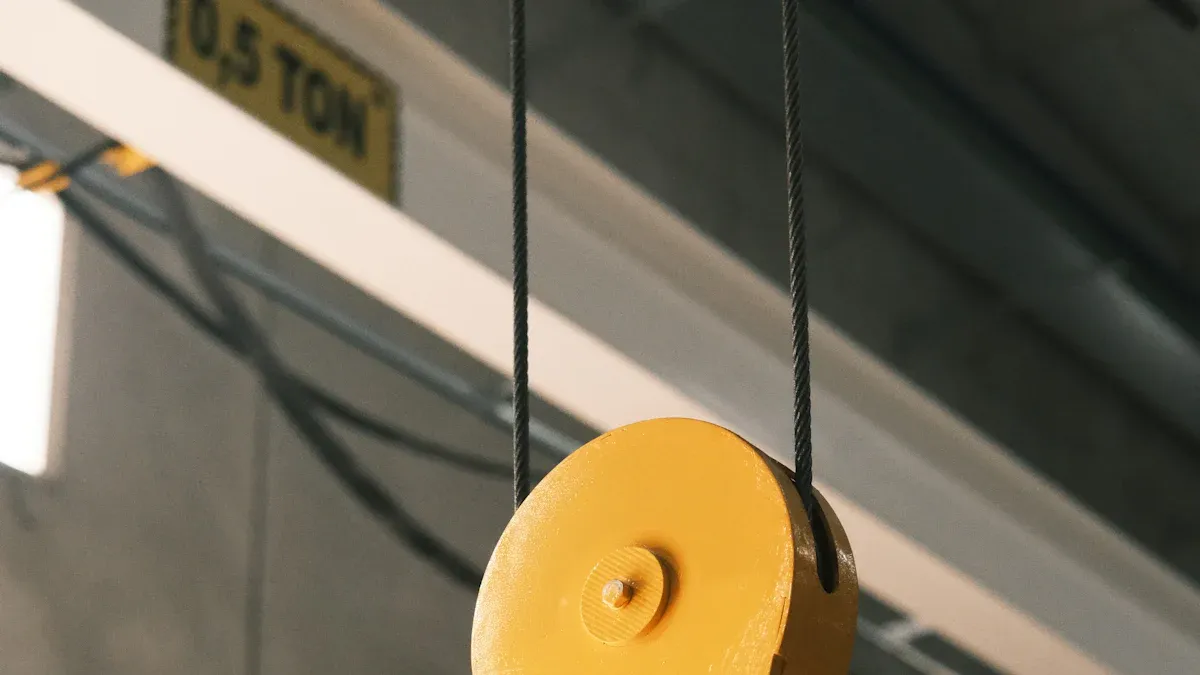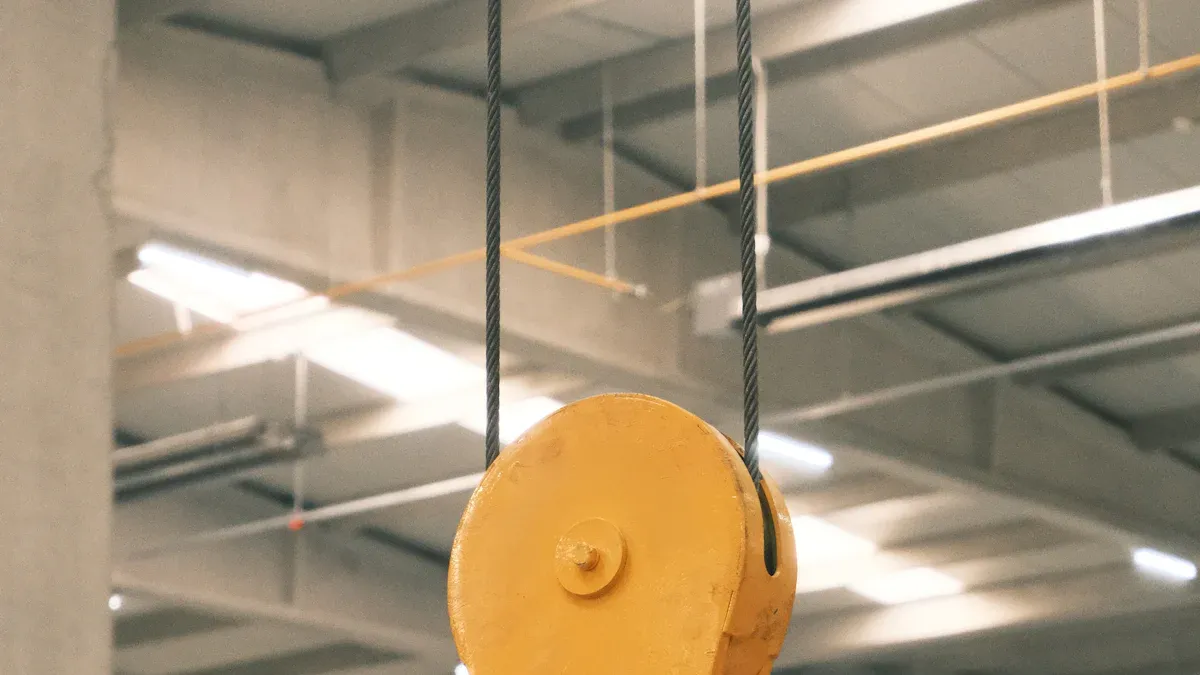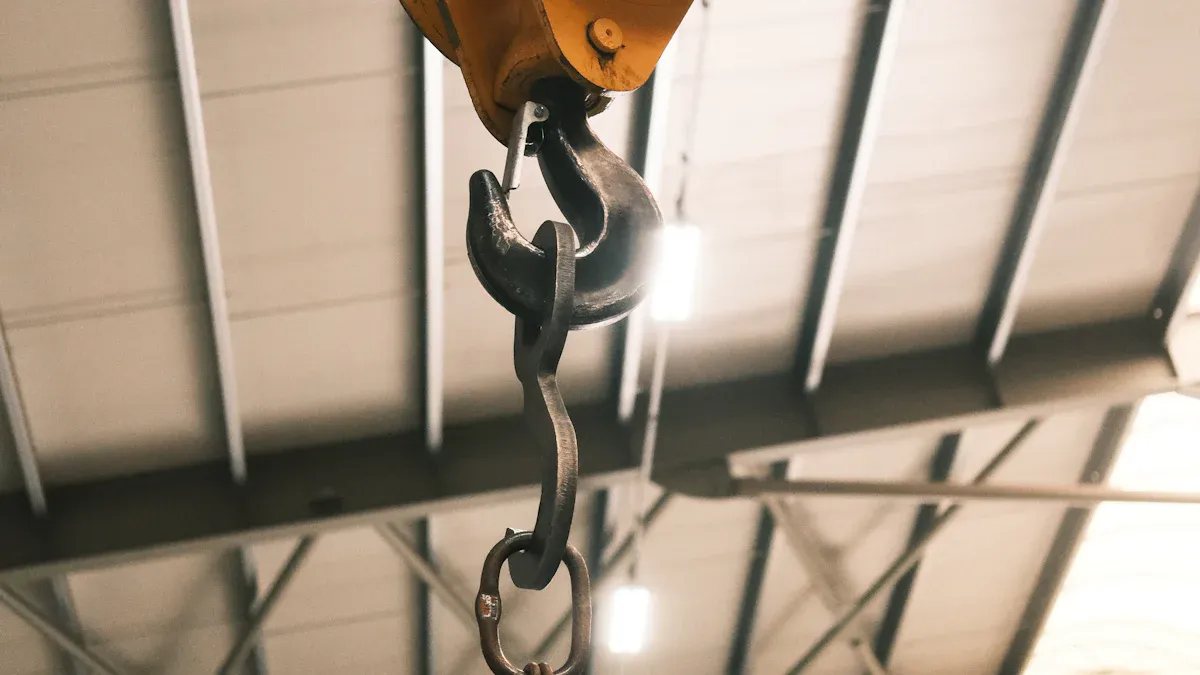
Choosing the right magnetic ceiling hooks can make a big difference in your space. Whether you’re hanging decorations, plants, or tools, the right hooks ensure everything stays secure and organized. A poor choice can lead to safety risks or damage. Pay attention to key factors like how much weight the hook can hold, what materials it’s made of, and how easy it is to install. Also, think about whether it matches your ceiling’s surface. When you get these details right, you’ll have hooks that are not just functional but reliable too.
Key Takeaways
- Always check how much weight the hooks can hold. This keeps things safe and avoids accidents.
- Pick the right material for what you want to hang. Strong metals like steel or neodymium are good for heavy stuff. Plastic is fine for light decorations.
- Measure the hook size and the space where it will go. This stops you from picking hooks that are too big or small.
- Test your ceiling with a small magnet first. If it sticks, you can use magnetic hooks. If it doesn’t, try other options like sticky plates.
- Read reviews and compare products to find good hooks. Look for ones that are strong and not too expensive.
Weight Capacity of Magnetic Ceiling Hooks
Why Weight Capacity Is Crucial
When choosing magnetic ceiling hooks, weight capacity is one of the most important factors to consider. It determines how much weight the hook can safely hold without slipping or falling. If you exceed the weight limit, you risk damaging your ceiling or causing items to fall, which can lead to accidents.
Think about this: Would you trust a hook to hold a heavy plant or a chandelier if you weren’t sure it could handle the weight? Probably not. That’s why understanding weight capacity is essential. It’s not just about safety—it’s also about protecting your belongings and ensuring the hooks perform as expected.
Tip: Always check the manufacturer’s specifications for weight capacity before buying. This small step can save you a lot of trouble later.
Determining the Right Capacity for Your Needs
Figuring out the right weight capacity for your magnetic ceiling hooks doesn’t have to be complicated. Start by identifying what you plan to hang. Is it lightweight, like holiday decorations, or heavier, like tools or storage baskets?
Here’s a simple way to decide:
- Weigh Your Items: Use a scale to measure the weight of the items you want to hang.
- Add a Safety Margin: Choose hooks with a weight capacity that’s at least 20-30% higher than the total weight of your items. This ensures stability and reduces the risk of failure.
- Consider Multiple Hooks: For heavier items, distribute the weight across multiple hooks to avoid overloading a single one.
Note: If you’re unsure, go for hooks with a higher weight capacity. It’s better to be safe than sorry.
Avoiding Common Weight-Related Mistakes
Mistakes happen, but you can avoid them with a little planning. Here are some common errors people make when choosing magnetic ceiling hooks:
- Ignoring Weight Limits: Some people assume all hooks are the same and don’t check the weight capacity. This can lead to accidents.
- Overloading Hooks: Hanging items that are too heavy for the hooks can cause them to detach from the ceiling.
- Using the Wrong Surface: Magnetic ceiling hooks work best on metal surfaces. If your ceiling isn’t magnetic, the hooks won’t hold properly, no matter the weight capacity.
To avoid these pitfalls, always read product descriptions carefully and test the hooks before hanging anything valuable.
Reminder: If you’re hanging something fragile or expensive, double-check the weight capacity and surface compatibility.
Materials Used in Magnetic Ceiling Hooks
Popular Materials and Their Characteristics
When it comes to magnetic ceiling hooks, the material they’re made of plays a huge role in their performance. You’ll often find hooks made from materials like neodymium, steel, or plastic. Each one has its own strengths.
- Neodymium: This is a type of rare-earth magnet. It’s incredibly strong and can hold a lot of weight for its size. If you need heavy-duty hooks, neodymium is a great choice.
- Steel: Steel hooks are durable and resistant to wear. They’re often coated to prevent rust, making them ideal for long-term use.
- Plastic: Lightweight and affordable, plastic hooks are better for lighter items. They’re not as strong as metal options but work well for decorations or small objects.
Tip: Always check the material before buying. It can make a big difference in how well the hooks perform.
Choosing the Best Material for Durability and Strength
Picking the right material depends on what you’re hanging. For heavier items like tools or plants, go with neodymium or steel. These materials provide the strength and durability you need. If you’re hanging something lightweight, like party decorations, plastic hooks might be enough.
Think about where you’ll use the hooks too. In damp areas like bathrooms or kitchens, rust-resistant materials like coated steel are a smart choice. For outdoor use, make sure the hooks can handle exposure to the elements.
Reminder: Stronger materials may cost more, but they’re worth it for safety and reliability.
Material Considerations for Specific Applications
Different tasks call for different materials. For example:
- Workshops or garages: Use steel or neodymium hooks for tools and equipment.
- Living spaces: Plastic hooks work well for lightweight decorations.
- Outdoor areas: Choose weather-resistant materials like coated steel.
By matching the material to your specific needs, you’ll get the most out of your magnetic ceiling hooks.
Size and Design of Magnetic Ceiling Hooks

How Size Affects Performance
Size plays a big role in how well magnetic ceiling hooks work. Larger hooks often have stronger magnets, which means they can hold more weight. Smaller hooks, on the other hand, are better for lightweight items like fairy lights or small decorations.
If you choose a hook that’s too small for your needs, it might not hold securely. On the flip side, oversized hooks can look bulky and unnecessary for lighter items. The key is to match the size of the hook to the weight and type of item you’re hanging.
Tip: Always check the dimensions of the hook before buying. This ensures it fits your space and performs as expected.
Selecting the Right Size for Your Space
When picking the size, think about where you’ll use the hooks. For small spaces like closets or kitchens, compact hooks are a better fit. They save space and keep things organized without being intrusive. In larger areas, like garages or living rooms, bigger hooks can handle heavier items and make a bold statement.
Measure the area where you plan to install the hooks. This helps you avoid hooks that are too large or too small for the space. Also, consider the height of your ceiling. If it’s low, smaller hooks might work better to avoid cluttering the view.
Matching Design to Functionality and Aesthetics
Magnetic ceiling hooks come in various designs, from sleek and modern to colorful and fun. Choose a design that complements your space. For example, black or metallic hooks look great in industrial or minimalist settings. Brightly colored hooks can add a playful touch to kids’ rooms or creative spaces.
Functionality matters too. Some hooks have swivel heads or adjustable features, making them more versatile. Look for designs that not only look good but also make your life easier.
Reminder: A well-designed hook should blend into your space while serving its purpose effectively.
Installation Tips for Magnetic Ceiling Hooks
Simplifying the Installation Process
Installing magnetic ceiling hooks doesn’t have to be a hassle. You can make the process quick and easy by preparing ahead of time. Start by identifying the exact spot where you want to place the hook. Make sure the surface is clean and free of dust or grease. A clean surface helps the magnet stick better and ensures it stays in place.
Next, test the hook on the surface before hanging anything. This step lets you check if the magnet holds securely. If it doesn’t, you might need to adjust the position or choose a different spot. For lightweight items, you can often install the hook without any tools. Just attach it to the ceiling, and you’re good to go!
Tip: Keep a small step stool or ladder handy. It makes reaching the ceiling safer and more comfortable.
Tools and Techniques for Secure Attachment
For heavier items, you’ll need a few tools to ensure the hook stays secure. A stud finder can help you locate metal beams or other magnetic surfaces in your ceiling. If you’re working with a painted or coated surface, consider using a protective layer, like a thin cloth, between the magnet and the ceiling. This prevents scratches.
When attaching the hook, press it firmly against the surface. Give it a gentle tug to test its grip. If it feels loose, reposition it or try a stronger magnetic hook. For non-magnetic surfaces, you might need adhesive-backed hooks or a mounting plate to create a secure base.
Reminder: Always double-check the weight capacity of the hook before hanging anything heavy.
Ensuring Long-Term Stability and Safety
To keep your magnetic ceiling hooks stable over time, inspect them regularly. Check if the magnet is still holding firmly and hasn’t shifted. Dust and debris can weaken the grip, so wipe the surface and the magnet occasionally.
Avoid overloading the hook, even if it seems sturdy. Over time, excessive weight can cause the magnet to lose its strength. If you notice any signs of wear, like rust or reduced grip, replace the hook immediately.
Pro Tip: Rotate your hooks occasionally to prevent wear and tear in one spot. This simple step can extend their lifespan.
Surface Compatibility for Magnetic Ceiling Hooks

Identifying Suitable Surfaces
Not all ceilings are created equal when it comes to using magnetic hooks. Before you buy, take a moment to think about the type of surface you’ll be working with. Magnetic ceiling hooks work best on metal surfaces because the magnet needs something ferrous to cling to. If your ceiling is made of steel or has a metal grid, you’re in luck! These surfaces provide the strongest hold.
But what if your ceiling isn’t metal? Don’t worry. You can still use magnetic hooks in creative ways. For example, drop ceilings often have metal frames that magnets can attach to. Even some painted or coated metal surfaces can work, as long as the coating isn’t too thick.
Tip: Use a small magnet to test your ceiling before committing to a purchase. If the magnet sticks firmly, you’re good to go!
Testing Compatibility Before Purchase
Testing compatibility is a smart move that can save you time and frustration. Here’s how you can do it:
- Grab a Magnet: Use any small magnet you have at home.
- Test the Surface: Hold the magnet against your ceiling. Does it stick? If yes, you’ve got a compatible surface.
- Check the Strength: Gently tug on the magnet. If it feels secure, your ceiling can handle magnetic hooks.
If you’re shopping online or in-store, look for product descriptions that mention surface compatibility. Some hooks are designed specifically for certain materials, like steel or aluminum. Reading reviews can also give you insight into how well the hooks work on different surfaces.
Reminder: Avoid using magnetic hooks on surfaces like wood, plaster, or drywall unless you have a workaround. These materials won’t provide the magnetic pull needed for a secure hold.
Adapting Hooks for Non-Magnetic Surfaces
What if your ceiling isn’t magnetic? Don’t give up just yet! There are ways to adapt magnetic hooks for non-magnetic surfaces. One popular solution is to use adhesive-backed metal plates. These plates act as a base for the magnet, allowing you to use the hooks even on wood or drywall.
Here’s how you can do it:
- Step 1: Clean the surface where you’ll place the metal plate.
- Step 2: Attach the adhesive plate securely.
- Step 3: Once the plate is in place, attach your magnetic hook to it.
Another option is to use hooks with dual functionality. Some magnetic hooks come with additional adhesive or screw-in options, making them versatile for different surfaces.
Pro Tip: If you’re hanging something heavy, make sure the adhesive plate or alternative method can handle the weight. Always double-check the weight capacity to avoid accidents.
Practical Advice for Choosing Magnetic Ceiling Hooks
Comparing Products and Reading Reviews
When shopping for magnetic ceiling hooks, comparing products is a smart move. Not all hooks are created equal, and taking the time to evaluate your options can save you from disappointment. Start by checking the product descriptions. Look for details like weight capacity, materials, and surface compatibility. These specs give you a clear idea of what to expect.
Reading reviews is just as important. Customer feedback often reveals things you won’t find in the product description. For example, reviewers might mention if the hooks lose their grip over time or if they’re tricky to install. Pay attention to both positive and negative comments. They’ll help you spot patterns and decide if the product is worth your money.
Tip: Focus on reviews with photos or videos. They often provide a more honest look at the product.
Balancing Quality and Affordability
Finding the perfect balance between quality and affordability can feel tricky, but it’s not impossible. You don’t have to spend a fortune to get reliable magnetic ceiling hooks. Start by setting a budget. Knowing how much you’re willing to spend helps narrow down your choices.
Next, compare prices across different brands. Sometimes, a higher price reflects better materials or stronger magnets. Other times, it’s just a fancy label. Look for hooks that offer good value for their price. If you’re unsure, go for mid-range options. They often strike the right balance between cost and performance.
Reminder: Cheap doesn’t always mean bad, but avoid hooks that seem too good to be true. They might not last long.
Finding Reliable Retailers and Brands
Choosing the right retailer or brand makes a big difference. Well-known brands often have a reputation for quality, so they’re a safe bet. However, smaller brands can also offer great products if you do a little research.
Stick to retailers with good return policies. This gives you peace of mind in case the hooks don’t meet your expectations. Online marketplaces like Amazon or specialty hardware stores are great places to start. Check if the retailer provides detailed product information and customer support. These are signs of a trustworthy seller.
Pro Tip: Ask friends or family for recommendations. Personal experiences can lead you to hidden gems.
Choosing the right magnetic ceiling hooks boils down to understanding a few key factors. You need to think about weight capacity, material, size, installation ease, and surface compatibility. Each of these plays a role in how well the hooks perform and how safe they are for your space.
Take the time to assess your needs. Are you hanging lightweight decorations or heavier tools? Matching the hooks to your specific requirements ensures you get the best results. Prioritize safety and quality over price. Reliable hooks protect your belongings and give you peace of mind.
Tip: Don’t rush the decision. A little research goes a long way in finding hooks that work perfectly for you.
FAQ
How do I know if my ceiling is compatible with magnetic hooks?
Use a small magnet to test your ceiling. If it sticks firmly, your ceiling is compatible. For non-magnetic surfaces, consider adhesive-backed metal plates or dual-function hooks.
Tip: Test multiple spots to find the strongest magnetic areas.
Can magnetic hooks damage my ceiling?
Magnetic hooks won’t damage metal ceilings. For painted or coated surfaces, use a protective layer like a cloth to prevent scratches. Avoid overloading the hooks to keep your ceiling safe.
What’s the best way to clean magnetic hooks?
Wipe them with a damp cloth to remove dust and debris. For rust-resistant hooks, use a mild cleaner. Regular cleaning ensures a strong grip and extends their lifespan.
Are magnetic hooks safe for hanging heavy items?
Yes, as long as you choose hooks with the right weight capacity. Always check the manufacturer’s specifications and add a safety margin. For very heavy items, distribute the weight across multiple hooks.
Can I use magnetic hooks outdoors?
Absolutely! Just pick hooks made from weather-resistant materials like coated steel. These can handle exposure to rain and humidity without losing their grip.
Reminder: Regularly inspect outdoor hooks for rust or wear.
Post time: Jun-05-2025
